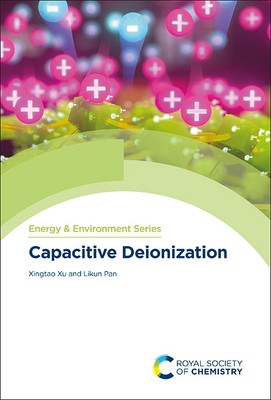
- We will send in 10–14 business days.
- Author: Xingtao Xu
- Publisher: Royal Society of Chemistry
- ISBN-10: 1839162368
- ISBN-13: 9781839162367
- Format: 15.8 x 23.6 x 2.5 cm, hardcover
- Language: English
- SAVE -10% with code: EXTRA
Reviews
Description
The exploration of new-family desalination techniques has become increasingly important in recent decades. Capacitive deionization (CDI) has attracted multidisciplinary interest as a promising alternative to conventional desalination techniques of reverse osmosis and electroosmosis, due to several attractive features such as low energy consumption, environmental friendliness and high water utilization efficiency. CDI desalts saline water through storing ions in electrical double layers of porous carbons or by redox reactions with faradic materials. This will be the first book to specialise in all aspects of CDI and aims to showcase the fundamentals and progressive achievements of the research. Chapters will cover theoretical models, the expansion of new-family electrode materials, exploitation of new-concept CDI devices and applications of CDI in other new areas. In addition, it will provide new insights into future directions for the development of CDI. Edited by a founder of the field, the book will be of interest to those researching water desalination and purification across chemistry, materials science and environmental science.
EXTRA 10 % discount with code: EXTRA
The promotion ends in 18d.11:28:05
The discount code is valid when purchasing from 10 €. Discounts do not stack.
- Author: Xingtao Xu
- Publisher: Royal Society of Chemistry
- ISBN-10: 1839162368
- ISBN-13: 9781839162367
- Format: 15.8 x 23.6 x 2.5 cm, hardcover
- Language: English English
The exploration of new-family desalination techniques has become increasingly important in recent decades. Capacitive deionization (CDI) has attracted multidisciplinary interest as a promising alternative to conventional desalination techniques of reverse osmosis and electroosmosis, due to several attractive features such as low energy consumption, environmental friendliness and high water utilization efficiency. CDI desalts saline water through storing ions in electrical double layers of porous carbons or by redox reactions with faradic materials. This will be the first book to specialise in all aspects of CDI and aims to showcase the fundamentals and progressive achievements of the research. Chapters will cover theoretical models, the expansion of new-family electrode materials, exploitation of new-concept CDI devices and applications of CDI in other new areas. In addition, it will provide new insights into future directions for the development of CDI. Edited by a founder of the field, the book will be of interest to those researching water desalination and purification across chemistry, materials science and environmental science.


Reviews